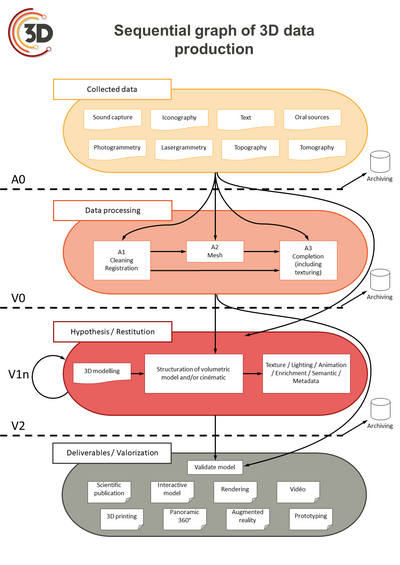Workflow:Life Cycle of 3D Data for Cultural Heritage
Workflow Description
The steps are:
- A0: acquired data
- V0: processed data
- V1n: hypotheses and restitutions loops and options
- V2: approved restitutions
Each step may be archived independently. The AIP should be properly linked.All steps may be gathered in a single archive.
A0 - Raw data - Archived
A0 = raw acquired data
For example:
| Process | Data | File type |
|---|---|---|
| Photogrammetry | 2D color pictures | tiff, dng, ... |
| Lasergrammetry | point-cloud | ply ASCII, ... |
| Tomography | shades of grey 2D picture+ descriptions | ANALYZE (hdr + img), DICOM |
| Archives / historical sources | 2D pictures, texts, sound, 3D ... | png, jpg, pdf, ogg, ply, |
| Other | GPS data, color calibration target, acquisition process | txt |
These data are the most important to archived. They are the primary sources and the condition for the data to be re-used (i.e. the purpose of an archive).
V0 - Processed data - Archived
V0 = A0 + basic human action + software process.
This is the first 3D technically validated by a human.
It may have been:
- cleaned
- assembled
- meshed
- holes filled
- textured with acquired 2D images
For example:
| Process | VO |
|---|---|
| Photogrammetry | mesh or the point-cloud based on the pictures only.With human choices for parameters and manual cleaning, selecting points, georeferecencing, etc. |
| Lasergrammetry | cleaned point-cloud, meshed, georeferenced, etc. |
| Tomography | - |
| Archives / historical sources | V0 doesn’t exist |
These data are archived, because they are the basis of the humanity work.
V1n - Restitutions - NOT archived
V1n = v0 + human knowledge
V1n means: v1a, v1b, v1c, ...
These are the restitution steps or options.It includes humanity knowledge contribution (archaeological, historical, medical, etc.).
They are working data, options and trials. These loops express the recursive aspect of the work with hypothesis and restitution stages.
It may have been:
- semantically enriched
- completed (missing parts)
- animated
These data are not archived because they are work-in-progress files.
V2 - Approved restitutions - Archived
V2 = scientifically approved V1n
I concerns the approved options developed in V1n.
I may be approved by any scientific committee.
In the best case it is related to a published article.
These data are archived because they show the outcome of the project.
Purpose
It presents the steps of the production process in a simplified way. The system of the graph has been defined to follow a logical path with notably the use of loops to express the recursive aspect of the work on data, especially during the hypothesis and restitution stages.
In a 3D restitution process: which data may be archived?
This workflow defines different steps in the creation of 3D data in humanities and social sciences.
It identifies how and when 3D data is produced.
It chooses 3D data for archiving.
Context
3D is now commonly used for Cultural Heritage study, valorization and preservation. The gathered experiences make possible to define standard processes and practices to ensure data quality and their preservation. Under the supervision of the French national infrastructure for digital humanities (Huma-Num), the Consortium "3D for Humanities" has thus defined a life cycle of such data from creation up to archiving. It was part of its missions that are: bring together groups working in the field of archaeology and cultural heritage and with experience of using 3D technologies and producing 3D models; define the vocabulary associated with 3D technologies for HSS; develop specific open-source 3D tools; disseminate good practices and commissioning a conservatory dedicated to 3D data. This 3D life cycle was initially designed for archeology, and is now open to any humanity field.
Content
This workflow is designed to work with 3D data from raw acquired data to restitution. We have formalized the different steps of data life Cycle. The first step consists in collecting data production from capture device (laser scanner, digital camera…). Such data which are denominated A0. The second step consists in processing the data (cleaning, meshing,…) to create the initial models V0. Finally, new modeling may be added to add new hypotheses for the restitution. This step may be iterated creating V1n versions up to the V2 that is the final version. A supplementary step may be added when valorization is considered. All versions from A0, V0 up to V2 are candidates for archiving. We have formalized this process with a sequential graph that introduces a metadata new schema dedicated to the long-term archiving of 3D models for HSS. We have also created a software aLTAG 3D, that leverage the usual complexity of documentation to create metadata and of checking that the 3D files are suitable for archiving. It creates an archive that can be pushed to the CINES – the French national infrastructure for high-performance computer, and for long-term digital preservation.
Evaluation/Review
Applied workflow in all team of the french consortium for 3D. This workflow is being updated to work with fields of humanities others than cultural heritage.
Further Information
Xavier Granier, Laurent Bergerot, Mehdi Chayani, Bruno Dutailly, Pascal Mora, et al. 3D lexicon for Human and Social Sciences. Recommendations of the "Consortium 3D for Humanities", 2021. ⟨hal-03187979⟩
Xavier Granier, Laurent Bergerot, Mehdi Chayani, Bruno Dutailly, Pascal Mora, et al. 3D lexicon for Human and Social Sciences. Recommendations of the "Consortium 3D for Humanities", 2021. p 6 ⟨hal-03187979⟩
Bruno Dutailly, Sylvie Eusèbe, Valentin Grimaud, Nicolas Lefèvre, Mathieu Quantin, et al.. Life cycle of 3d data for cultural heritage: Identify how and when 3D data is produced. Choose 3D file formats for archiving. Define a robust process for producing 3D data and preserving it. Visual Heritage 2018, Nov 2018, Vienne, Austria. ⟨hal-01926434⟩
